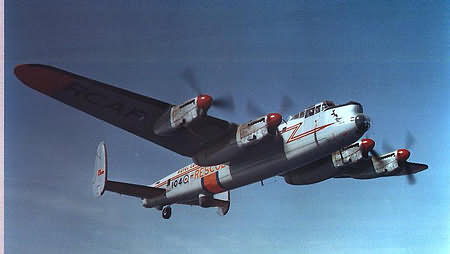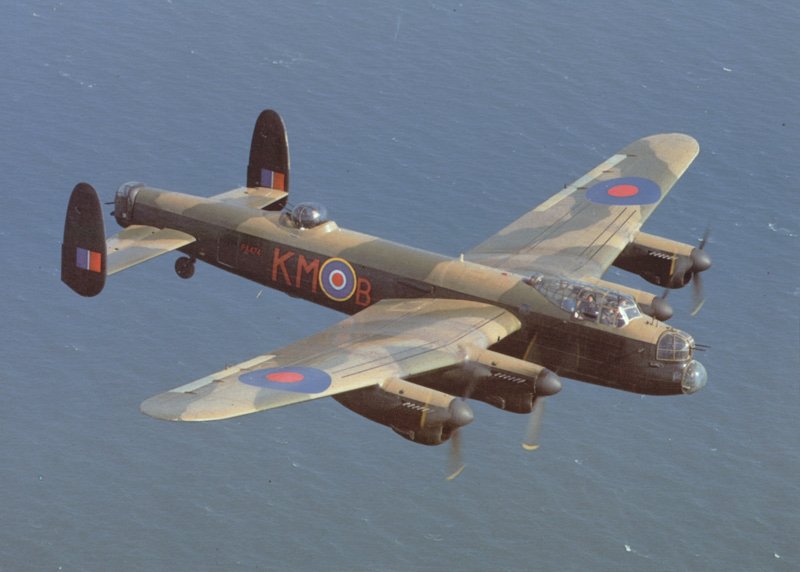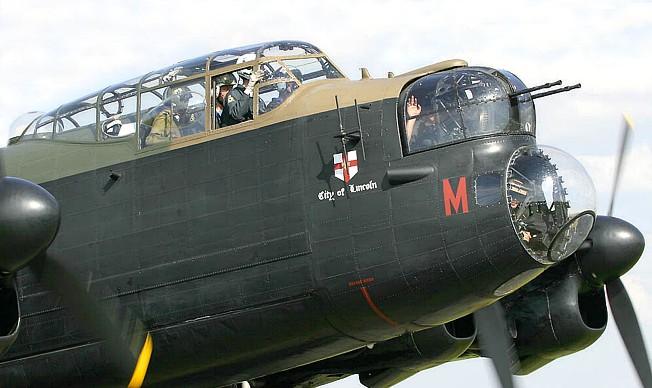Avro 683-Lancaster
The most powerful bomber of the RAF.

Raids on dams in the Ruhr. Night bombing. Raids on Pilsen.
 -Picture on the left: The second Canadian "airworthy" Avro lancaster B Mk.10
with the mark FM104.(It is now undergoing a complete reconstruction.)
-Picture on the left: The second Canadian "airworthy" Avro lancaster B Mk.10
with the mark FM104.(It is now undergoing a complete reconstruction.)
This heavy four-engine bomber was actually created out of the need to "improve" in that currently deficient bomber Avro 679 Manchester, whose two engines Rolls & Royce Valture II., Did not meet the required needs for RAF bombers. Designers Avro companies were already considering how to "improve" the failed Manchester. The Ministry of Aviation did send an official order in January 1940 to new Manchester Mk.III. It was the installation of four in - line Merlin engines in modified wing and the same fuselage of Manchester. That really worked out and stuff could begin production of a new aircraft in November 1940, the Avro 683 with an attribute Lancaster. Prototype aircraft mark. Type 683 from the first series, had a third tail area as its predecessor Manchester. After testing at the research institute aircraft (A & AEE) got a new tail area with larger rudders and middle the original rudder disappeared. In May, the second prototype completed was already fitted all ten machine guns in the turrets and also had a larger bomb bay where it could fit cool so-called Cookie bomb weighing 3700 kg. Lancaster tests have shown actual usability of this aircraft. Thanks to the 4th Rolls & Royce Merlin XX engines. O power 940 kW. flew and was manageable even with a load of almost 28000 Kg. Serial Lancaster production began in June 1941, at the instigation of an order from the ministry aviation for 50pcs. of these aircraft. The first serial Lancaster Mk. I. was great four-engine bomber with a crew of seven men, flying at an altitude of 7500m. with range of almost 2700 km. and a bomb load of 6000kg. Production took place in many companies (Vickers, Austin motors, Armstrong Whitworth). The main production was in A.V. Roe Co. Ltd. (AVRO) in Manchester-Chadderton, the Parts were then assembled and aircraft flew in almost 30km. remote Woodford. Lacaster variant many was not, Mk.I. was cooked in large series.The changes concerned the engines-Merlin XXII. (speed: 434km / h) and Merlin XXIV., with takeoff. hm. 28600 and 32690 kg, respectively. For lack of Merlin engines, were used in September 1942 by the Lancasters fourteen-cylinder Bristol Hercules VI star engines with an output of 1275 kW. These Lancasters were marked as Mk. II. sometimes differed by a larger bomb bay. Then there were also mounted Hercules XVI engines, which, however, compared to Lance with in-line engines reached lower flight altitudes. By May 44, about 300 had been produced Lancasters Mk.II. (180 pcs. Lost in combat). Another of the variants Mk. III. see v essentially did not differ from Mk. I. neither given nor parameters. Others were just used engines (American licensed Merlin 28,38,244). Another variant was the 7th pc. Mk.VI. with R&R Merlin 84 engines in 44. Mk. Var. Mk. VII. she was just shifted turret on the top of the fuselage.Lancastery made in Canada by Victory Aircraft Ltd. in Ontario, were marked Mk.X. (but based on the type Mk. III., 430Ks. with Merlin 38 and Merlin 224 engines).
And how did the Czechs meet the Lancasters?
The war was coming to an end, and everyone eagerly awaited peace. Even the
inhabitants West Bohemian Pilsen. But instead they were bombed. Four o'clock
in the morning April 17, 1945: The darkness over the city was lit by thousands
of flares, dropped from the 10th accompanying Mosquit. 222 Lancasters no. 5.
Group, filled the sky over Pilsen. He started raiding on Pilsen railway
station. Twenty minutes of total devastation. During this time they thundered
in Pilsen bombs. Then there was silence and darkness, interrupted only
somewhere by a burning fire. It was destroyed dozens of railway tracks,
thousands of wagons, 80 locomotives, railway depot and many other buildings.
Two bombs also hit the station building. One moved a huge one the dome of the
station building and the other collapsed to the station shelter, where she
killed several hundred German and Hungarian soldiers and refugees from East
Germany, waiting for trains. The passing train with ammunition, which it
exploded mightily. The exact numbers of hugs are not known but it is estimated
that 850 people died. Not all the bombs hit the station: Many were destroyed
civil houses: the city slaughterhouse, the working-class neighborhood called
the Gypsy was totally The bombs also fell on the nearby district of Doubravka
and its part Letná, as well as in Pilsen brewery. 350 railway workers and
civilians died in the station shelter 891 tons of bombs and 5 tons of
incendiary bombs were dropped. Among them as well 168. 1815kg. bombs called
"Cookie" (biscuit, This is how the people of Pilsen met in April 1945 Avro 683
Lancaster.
Pilsen in Doubravka, with the names of citizens who perished, April 17, 1945
(on the site by bombing houses destroyed).Details of the memorial plaque (note:
At present, the memorial is relocated about 50 m below the stairs under Sousedská
Street)
Avro Lancaster mark.PO-S nr.:R5868
 Avro 683 Lancaster B1 mark.KM-B č.:PA474 above sea level:
One of only two airworthy Lancasters.
Avro 683 Lancaster B1 mark.KM-B č.:PA474 above sea level:
One of only two airworthy Lancasters.
 Lancaster cab detail,
sights and turrets:
Lancaster cab detail,
sights and turrets:
.jpg) Avro Lancaster I No. R5868 PO-S, RAF Museum Hedon-London. The aircraft
graduated from various squadron a total of 139 combat missions, which is due
to the losses a respectable performance!This machine is a model of the
Lancaster model(kit) above in the photos:
Avro Lancaster I No. R5868 PO-S, RAF Museum Hedon-London. The aircraft
graduated from various squadron a total of 139 combat missions, which is due
to the losses a respectable performance!This machine is a model of the
Lancaster model(kit) above in the photos:
Technical data of the AVRO 683 Lancaster Mk.I bomber:
Heavy bomber with a crew of 7 men. Drive-4x in-line, liquid cooled, twelve-cylinder Merlin XX or 22 engine with an output of 1074kW. Range-31. 09m, height-6. 19m, wing area-120m. Weight-empty = 16750kg, takeoff: 32680kg. Performances: max. speed-416-462km / h (according to height). ascent-7468m, range-with additional tanks and 3180kg. cost bomb: 4315km. Armament-2x machine gun Browning Mk.II.ráže 7.7mm in the front turret (frazer-Nasch) after 1000 rounds per weapon, 2x machine gun 7.7mm in the dorsal turret (FN 50) 1000 babies per weapon, four x machine gun in the rear turret (FN 20) after 2500 rounds per weapon. The first aircraft had in addition 2x machine guns 7. 7 v lower remote control tower, 750 each bullets on the weapon. Bombs in the monument until weighing 6350kg, or one Grand Slam weighing 10150kg.
Contact on : kontakt@zajimava-letadla.czThank you in advance for your opinions!
c- Buschman.aerospace,Vladimír Kroft - 2007-2021, All rights reserved by the author!
Copying and using text and images without the prior consent of the author of these pages is prohibited, according to the valid copyright laws of the Czech Republic and the European Union!
If the internet wind brings someone here who also has similar sites, they will be happy to I'll look at the pages of more experienced or even less experienced followers letadel.For your links to your or other interesting www in advance.Buschman.